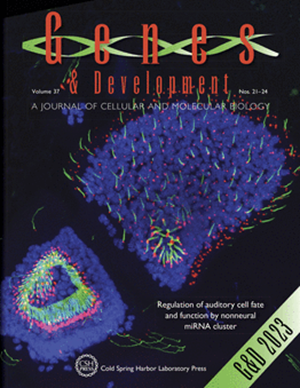冈比亚按蚊胚胎发育过程中性别特异性转录组动力学
IF 7.7
1区 生物学
Q1 CELL BIOLOGY
引用次数: 0
摘要
传播疟疾的蚊子在它们的解剖结构和行为上都是两性异形的。冈比亚按蚊(Anopheles gambiae)的性别特异性基因表达在成虫阶段得到了很好的研究,但除了Yob等性别决定因素外,其在胚胎发生期间的发病情况在很大程度上仍然未知。在这里,我们报告一个综合单个胚胎转录组雄性和雌性按蚊的阿特拉斯的早期阶段建立性别表达网络。我们的数据集揭示了胚胎RNA异构体的多样性,包括在母体到合子基因组转变过程中向远端选择性多聚腺苷化(APA)事件位点的全球转移。性别偏倚的基因表达和选择性剪接在胚胎发生期间是有限的,大多数性别特异性模式出现在胚胎后。x染色体剂量补偿(DC)在受精卵基因组激活后不久建立,伴随着主调节蛋白SOA与x连锁启动子的直接结合。与其他物种中已知的直流电调节因子相比,我们没有在按蚊中发现早期高亲和力位点或距离依赖模式的证据。相反,SOA绑定和DC是根据基因活性在基因上动态指定的,其中表达最强烈的基因往往显示出最强的SOA绑定。我们认为按蚊DC系统代表了一个在全染色体水平上运作的基因调控机制的极端案例。本文章由计算机程序翻译,如有差异,请以英文原文为准。
Sex-specific transcriptome dynamics of Anopheles gambiae during embryonic development
Malaria-transmitting mosquitoes are extremely sexually dimorphic in their anatomy and behavior. Sex-specific gene expression in Anopheles gambiae is well studied in adult stages, but its onset during embryogenesis, apart from sex determination factors like Yob, remains largely unknown. Here, we report a comprehensive single-embryo transcriptome atlas of A. gambiae males and females to understand the earliest stages of establishing the sex-specific expression networks. Our data set reveals embryonic RNA isoform diversity, including a global shift toward distal alternative polyadenylation (APA) event sites during the maternal-to-zygotic genome transition. Sex-biased gene expression and alternative splicing are limited during embryogenesis, with most sex-specific patterns emerging postembryonically. X-chromosome dosage compensation (DC) is established shortly after zygotic genome activation, concomitant with direct binding of the master regulator protein SOA to X-linked promoters. In contrast to known DC regulators in other species, we did not find evidence for early high-affinity sites or distance-dependent patterns in Anopheles. Instead, SOA binding and DC are dynamically specified on genes according to gene activity, where the most strongly expressed genes tend to show the strongest SOA binding. We propose that the Anopheles DC system represents an extreme case of a gene-by-gene regulatory mechanism that operates at the chromosome-wide level.
求助全文
通过发布文献求助,成功后即可免费获取论文全文。
去求助
来源期刊

Genes & development
生物-发育生物学
CiteScore
17.50
自引率
1.90%
发文量
71
审稿时长
3-6 weeks
期刊介绍:
Genes & Development is a research journal published in association with The Genetics Society. It publishes high-quality research papers in the areas of molecular biology, molecular genetics, and related fields. The journal features various research formats including Research papers, short Research Communications, and Resource/Methodology papers.
Genes & Development has gained recognition and is considered as one of the Top Five Research Journals in the field of Molecular Biology and Genetics. It has an impressive Impact Factor of 12.89. The journal is ranked #2 among Developmental Biology research journals, #5 in Genetics and Heredity, and is among the Top 20 in Cell Biology (according to ISI Journal Citation Reports®, 2021).
 求助内容:
求助内容: 应助结果提醒方式:
应助结果提醒方式:


